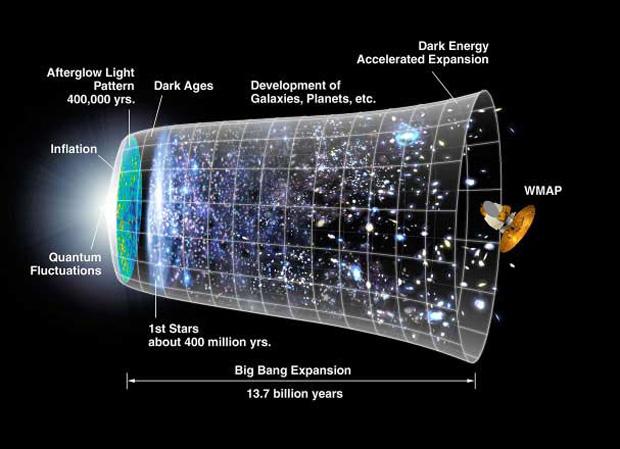Glimpse Before Big Bang Possible

The universe appears to be lopsided, and a new model that aims to explain this anomaly could offer a glimpse of what happened before the birth of it all.
When astronomers look out at the cosmos, the view in one direction is turning out to be different than in the other. Specifically, fluctuations in the density and temperature of the radiation left over from the theoretical Big Bang — called the Cosmic Microwave Background — seem to be strangely larger on one side of the universe.
A new model suggests this unevenness could be caused by an imprint left over from before the beginning of the universe, that is, before the cosmos ballooned almost instantaneously from less than the size of an atom to about golf-ball size. This process is called inflation.
Blowing up the balloon
"Inflation theory does predict that we have these density and temperature fluctuations, but they should look the same everywhere across the sky," said Caltech astrophysicist Sean Carroll, who worked on the new model, detailed in the Dec. 16 issue of the journal Physical Review D. "But people who look at the data say they see one side of the universe has bigger fluctuations, and that's what we're trying to get a handle on."
Scientists think the normal variations in temperature and density predicted by inflation became the seeds for the structure we see today throughout the universe. Soon after inflation, the denser areas would have attracted more matter and eventually grown into the clusters and galaxies we see today, while less dense regions would have become voids mostly absent of galaxies, stars and planets.
But the normal model of inflation can't account for the asymmetry now noted. To try to explain that, Carroll, astrophysicist Marc Kamionkowski and graduate student Adrienne Erickcek (all at Caltech) tested a new version of inflation theory, in which two fields are responsible for the universe's early bloom of expansion.
Get the Space.com Newsletter
Breaking space news, the latest updates on rocket launches, skywatching events and more!
In the standard theory of inflation, one field called the inflaton (not inflation) caused both the rapid expansion of the universe and its density fluctuations. But Kamionkowski and team found that an unevenness in the density fluctuations could arise if inflation is caused by two fields instead of one. In the new model, the inflaton is responsible for ballooning the size of the universe, while a second field called the curvaton that had been previously proposed introduces the density variations.
Before the Big Bang?
The model also intriguingly hints at what might have come before inflation, since it suggests that the universe's lopsidedness may be an aftereffect of a great fluctuation that occurred before inflation began.
"It's no longer completely crazy to ask what happened before the Big Bang," Kamionkowski said. "All of that stuff is hidden by a veil, observationally. If our model holds up, we may have a chance to see beyond this veil."
The next step is to gather better data about the Cosmic Microwave Background, to confirm that the unevenness seen so far really holds up.
"So far it seems to be in the data, but that doesn't mean it's in the universe," Carroll told SPACE.com. "There's a chance this asymmetry is coming from errors in the data."
A new European Space Agency satellite called Planck, designed to map the background radiation with unprecedented sensitivity and resolution, is set to launch in 2009. If Planck finds the radiation densities to be off-balance, too, then cosmologists must really come to terms with this puzzling aspect of inflation. Though it would require some serious amendments to current theories, many physicists would relish the challenge.
"That's what everyone wants — it's much more interesting that way," Carroll said.
- Top 10 Strangest Things in Space
- Greatest Mysteries: How Did the Universe Begin?
- 10 Confounding Cosmic Questions
Join our Space Forums to keep talking space on the latest missions, night sky and more! And if you have a news tip, correction or comment, let us know at: community@space.com.

Clara Moskowitz is a science and space writer who joined the Space.com team in 2008 and served as Assistant Managing Editor from 2011 to 2013. Clara has a bachelor's degree in astronomy and physics from Wesleyan University, and a graduate certificate in science writing from the University of California, Santa Cruz. She covers everything from astronomy to human spaceflight and once aced a NASTAR suborbital spaceflight training program for space missions. Clara is currently Associate Editor of Scientific American. To see her latest project is, follow Clara on Twitter.









